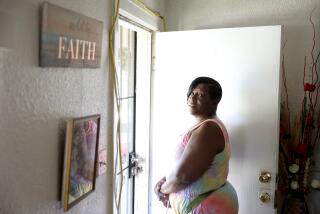A formula for foster care success
- Share via
A partner in a large Los Angeles law firm and a 17-year-old kid from Compton wouldn’t appear to have a lot in common. But both of our lives have been indelibly marked by the violence and neglect in our early lives, and changed by California’s foster care system. So we speak from experience when we urge Gov. Arnold Schwarzenegger to sign a bill (AB 12) that would enable our state to collect federal dollars dedicated to boosting foster kids’ chances of success.
Miles was kidnapped and held for days by drug dealers in Sacramento when he was 2 years old, and at just 5 years old found his mother dead of a drug overdose. He entered the foster care system at age 6 and experienced a world of upheaval in the early years before finding his way to college and eventually earning a law degree from UC Berkeley.
George is from gang-infested Compton, lived in six foster homes, moved from school to school and yet graduated from high school last year and now attends college.
Ours are among the few foster care stories with happy endings. Most of our peers in foster care wind up homeless, incarcerated or dead. Most foster youth are kicked out of the program and left on their own at the age of 18, so it is no surprise that more than half of former foster youth are arrested or in jail, according to a 2010 study from Chapin Hall at the University of Chicago.
The fact that more than half of foster youth will be unemployed and that more than 25% will be homeless on turning 18 no doubt contributes to that grim statistic. Pregnancy, prostitution, drugs, violence and poor health also often follow unemployment, homelessness and lack of guidance.
Well-regarded academic studies have shown that when young adults stay in foster care until age 21, their outlook for education, housing stability and mental health dramatically improve. Those three additional years of support help keep these young people safe, in school, off the streets and out of jail. A 2009 University of Washington study concluded that supporting California youth in foster care after age 18 returns $2.41 for every state dollar committed.
We were among the few exceptions who found additional support in the current system. Miles was fortunate to find a foster parent who kept him in her home for three years after high school so he could attend community college and then transfer to a four-year university. Currently, most foster youth do not have a stable environment after foster care.
George had the support of one of the few nonprofit agencies able to provide a stable environment, which allowed him to graduate from high school and attend college. There are too few nonprofits to provide such support, and the ones that exist have been forced to cut services.
The statistics are grim, but we know firsthand the difference that supporting foster youth until age 21 can make.
The California Fostering Connections to Success Act, AB 12, passed in August and awaiting the governor’s signature, would take advantage of new federal money specifically set aside for expanding foster care. California would not have to spend a single new dollar from the state’s general fund.
The governor started his California political career by signing the landmark Proposition 49, creating afterschool programs for the children of our state. Now, he has the opportunity to sign into law AB 12, perhaps the most important piece of bipartisan legislation in the history of our state.
Both of us emerged from our experiences in foster care with a message of hope: Foster youth are not broken people; they are resilient and smart, with latent talents and hopes. This is why AB 12 must be signed into law if there are to be more like us. Let us put the most vulnerable among us — at-risk foster youth — before politics.
Miles Cooley is a partner in a Los Angeles law firm and a board member of the John Burton Foundation. George White is attending his first year at Columbia College Hollywood. Both serve on the board of directors of Peace4Kids, a private nonprofit that provides direct services to youth in foster care.
More to Read
Sign up for Essential California
The most important California stories and recommendations in your inbox every morning.
You may occasionally receive promotional content from the Los Angeles Times.










